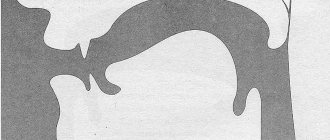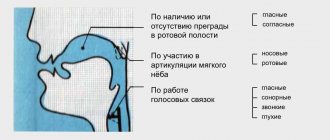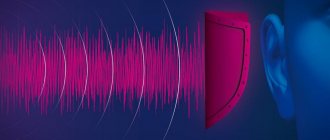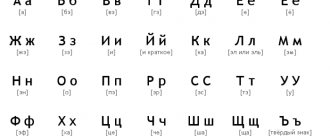Normal articulation of vowels
Normal articulation of vowels has common characteristics: the soft palate is located at the top and pressed against the back wall of the pharynx. As a result, the passage into the nasal cavity is closed, and the air stream is directed through the mouth. In this case, the vocal folds are in a tense state, they are brought together and vibrate, as a result of which a voice is formed.
- U:
- The lips are pulled forward like a tube.
- The teeth of the upper and lower rows do not touch; they are completely covered by the lips.
- The root of the tongue is retracted back deep into the oral cavity. The back of the organ is raised high to the palate.
- ABOUT:
- The lips are slightly extended forward and take on a rounded shape, but less than in the case of the U phoneme.
- The teeth are covered with lips.
- The tongue is pulled back: the back of its back rises in a lump towards the soft palate.
- A:
- The lower jaw is lowered; a distance of approximately 2 fingers (1-1.5 cm) is maintained between the incisors of the upper and lower jaws.
- The front teeth are slightly visible.
- The tongue is wide, flat, located at the lower teeth, its tip touches the lower teeth, the lateral edges are lowered to the lower chewing teeth.
- AND:
- The mouth is stretched so that it resembles a smile.
- Teeth slightly exposed.
- The tongue moves forward and upward.
- E:
- The mouth is stretched in a smile, but the opening is wider than when pronouncing the phoneme I.
- Teeth exposed.
- The tip of the tongue touches the lower incisors, the sides touch the upper molars, the back is raised, close to the hard palate.
- S:
- The lips are open freely.
- There is a gap between the incisors, which is much wider than when pronouncing the phoneme I.
- The tip of the tongue is strongly retracted, and the back of the organ is raised towards the palate, but does not touch it.
Disadvantages of vowel pronunciation
Among the shortcomings in the pronunciation of vowel sounds, there are those that are characteristic of the entire vowel series or several sounds from it.
- Nasalization, when the nasal resonator does not participate correctly in articulation: the entrance to the nasal cavity remains open. Considered a gross defect.
- Expanded articulation. The mouth opens wider than required for correct pronunciation. Because of this, the rounding of the lips when pronouncing labialized sounds becomes less. The rise of the tongue with such a wide opening is reduced.
- Narrowed articulation. The mechanism of action is the opposite of that described above. Considered a gross defect.
- Front articulation. Characteristic of O, U. Occurs due to the fact that the tongue is retracted slightly back into the mouth. In this case, its tip is close to the lower incisors, the back stands in a lump.
- Raising your voice. Severe pronunciation defect U, I.
- Y-shaped pronunciation when the vowel sounds close to Y. Typical for A, O, E, I.
There are pronunciation errors that are specific to specific sounds.
- And it sounds similar to L. In speech it will look like this: instead of writing, weep; instead of throwing, we cry.
- When pronouncing the phoneme E, the tongue peeks out of the mouth and rests on the lower lip.
Most often this happens when the child is shown too much articulation.
- Y. More protrusion of the lower jaw than necessary. As a result, the position of the jaws becomes similar to a progenic bite.
As a rule, it appears when the teacher incorrectly shows the differences between Y and I.
Stage three – automation in speech.
Since you are already familiar with this term, we will mention it here, because it best explains the last step towards correct and beautiful pronunciation. So, as you already understand, you have to learn how to use your new sound in speech, so that it turns out easily and naturally.
Now you will always and everywhere have to make sure that the acquired skills are put into practice and that your new sound pleases your ears. The sound that has been delivered and worked out will gradually take root and will never confuse you or attract the attention of others.
Share:
Find out more about the Center's services and sign up for a consultation or lesson
You can call (812)
640-90-77
, or by filling out the form below.
Technique for setting vowel sounds
Among the most common methods for producing vowel sounds is the method of F.F. Rau, N.F. Slezina and the methodology of K.A. Volkova.
The first of them provides:
- Pronounce the vowel for a long time as part of syllables and in isolation.
- Practice the vowel in syllables and in isolation, abruptly, briefly.
- Change the volume of the sound when pronouncing it.
- Pronounce the vowel phoneme, placing stress on it, as well as unstressed syllables and words.
- Distinguishing vowels in syllables.
K.A. Volkova suggests performing the following types of exercises:
- Speak the sound in isolation.
- Pronounce a vowel with tension in the articulatory organs: positions under stress; and at the beginning of a word; at the beginning of a syllable.
- Practice under stress and in an unstressed position.
- Pronounce at the beginning of a word, syllable, at the end, between consonants, i.e. change the position of the sound.
- Distinguish vowels in syllables and words.
Articulation gymnastics
The key to correct articulation of sounds, including vowels, is sufficiently developed mobility and switchability of the organs of the speech apparatus, as well as developed speech breathing. The functioning of the speech organs can be improved through articulatory gymnastics. There are various exercises for the lips, cheeks, lower jaw and tongue. It is good to give tasks in a playful way so that they arouse the child’s interest and desire to repeat them.
Exercise “Garazhik”. Let's imagine that the mouth is a garage into which cars drive. Once - open your mouth wide and hold it in this position for up to 5 seconds, until all the cars start moving. Two - close the garage. The tongue lies quietly at the bottom of the mouth. Repeat at least 3 times.
“Hamster.” The speech therapist shows a picture of a hamster, paying attention to how its cheeks are puffed up. Then he invites the child to puff out his cheeks too. When performing the task, the mouth must be closed. After 5 seconds, you need to release the air through your lips.
If the child does not succeed in this exercise, then you can simply invite him to blow, squeezing his lips with his fingers at this moment, as a result of which the air from inside will inflate his cheeks. Repeat 3 times.
"Puppy". The speech therapist shows a picture of a dog (she bares her teeth) and a boy (he smiles). The teacher draws the child’s attention to how the puppy and boy show their teeth and offers to show their teeth in the same way. The exercise is performed in front of a mirror 2-3 times. You can also read simple, funny poems on the theme of the picture.
Several articulatory gymnastics exercises can be united by a common theme. For example, invite your child to put animals from various exercises on a fun train. We’ll put a hamster in the first trailer (children puff out their cheeks), a puppy in the next one (smile), etc.
Also effective exercises include “Needle”, “Swing”, “Fence”, “Horse”.
English paired consonants /b–p/
Now let's talk about the promised lack of stunning/voicing of sound. In Russian there are processes:
- when a voiceless sound is in front of a voiced sound, it also becomes voiced: To p desyatka /to bd'is'atk /,
- when a voiced sound comes at the end of a word, it becomes voiceless: oak /dup/.
In English, the voiceless /p/ is not voiced when placed before a voiced sound: stop B
ob /stɒ
p b
ɒb/.
And the voiced /b/ is not devoiced in final position. It becomes weaker and shorter, but remains VOID! Otherwise, you can change the meaning of the word: cab (taxi) – cap (lid)
.
Listen to Chris Rock say club
.
We stay in the club b . We live in the club b . We die in the club b . We get our car washed in the clu b . We go to school in the club b . We go to the cleaners in the clu b .
From the very beginning of the video
EXERCISE.
Here are words ending in /b/ and /p/. Say them according to the transcription, without deafening the /b/ sound at the end. Remember that the sound /b/ becomes weaker and /p/ is pronounced with partial aspiration.
cu b
/kʌ
b / cu p
/kʌ
p /
li b
/lɪ
b / li p
/lɪ
p /
pu b
/pʌ
b / pu p
/pʌ
p /
ro be
/rəʊ
b / ro pe
/rəʊ
p /
ta b
/tæ
b / ta p
/tæ
p /
ca b
/kæ
b / ca p
/kæ
p /
ri b
/rɪ
b / ri p
/rɪ
p /
bu b
/bʌ
b / bum p
/bʌm
p /
clu b
/klʌ
b / clum p
/klʌm
p /
When you have mastered all the details of correct pronunciation, consolidate the result with tongue twisters.
For the sound /b/
- A B ritish b uilder b uilt a b uilding of b rown b ricks. A B ulgarian b uilder b uilt a b uilding of b lack b ricks.
- A b ig b lack b ug b it a b ig b lack b ear, a b ig b lack b ear b it a b ig b lack b ug.
- B etty's b a b y's name is B ar b y. B etty's B ar b y is a b ad- b ad b oy. B aby B ar b y is a b ad b ad b aby. B etty b ought a b right b lue b lanket for her b a b y- b oy.
For the sound /p/
- P retty P olly P erkins has a p air of p retty p laits.
- P eter P i p er p icked a p eck of p ickled p e p p er, a p eck of p ickled p e p p er P eter Pi p er p icked. If P eter P i p er p icked a p eck of p ickled p e pp er, where's the p eck of p ickled p e pp er P eter P i p er p icked?
- P ablo P icasso p ut off his p alette, p aintbox and p aintbrushes. And painted with p en a pic ture of a p eaceful p lace in P aris. With a p ink p alace and a p aled p ark p lenty of p retty p lants. What's the p ossible p icture 's rice?
Individual lessons in difficult cases
It is more logical to give preference to individual lessons in difficult cases when the pronunciation of vowel sounds is impaired (for example, in hearing-impaired and deaf children or with rhinolalia, dysarthria). To do this, the teacher has various ways of posing problem sounds in his arsenal.
For example, to eliminate Y-shaped articulation, in addition to imitative exercises, a mechanical method, when the speech therapist presses the back of the tongue with a spatula, has a good effect. The same method is also suitable for narrowing the articulation of vowels O, U.
If a child has anterior articulation of sounds, this can be eliminated mechanically as follows: press the front part of the tongue with a spatula and push it back.
To close the passage into the nasal cavity and eliminate nasal tint, lightly press the root of the tongue with a spatula.
The sound A is usually placed by imitation, in the game. For example, a child is given a doll and asked to show how to rock it: ah-ah.
The sound O is well placed mechanically, starting from A. The speech therapist asks the child to pronounce the sound A, and in the meantime he brings the child’s lips together, giving them a rounded shape. You can also use various rings or bagels.
A speech therapist performs similar actions when setting the U. Only now here you need to build on the set O and bring the child’s lips even closer together.
The sound E. It is placed by imitation, starting from the vowel A in comparison.
When setting the Y, you can build on the articulation of the I. A spatula is used, because The oral gap is narrow when pronouncing the phoneme I. The speech therapist should press slightly with a spatula on the anterior lobe of the tongue and move it slightly deeper into the mouth. You need to invite the child to compare the sound of the sounds I-Y in syllables. For example, Pi - Py. It is also necessary to control the position of the lower jaw - it should not move forward.
The first step is diagnosis.
If there is simply no sound, it is easier to “teach” the tongue and lips to take the desired shape for its pronunciation than if there is already a distorted pronunciation. Relearning is always more difficult, especially if it has been consolidated for decades, as is sometimes the case with adults.
The first thing the speech therapist will do at the appointment is to determine which sounds are being pronounced incorrectly and what exactly needs to be done to help you change the situation. The process will be easier and simpler when everything is fine from a physiological and audiological point of view. That is, the organs of speech and hearing function normally.
But it also happens that a person cannot pronounce a complex sound correctly for other reasons. For example, a short frenulum makes it impossible to fully place the tongue in the upper position, which will not allow one to master “r”, “w”, “w”, “l”. Violation of phonetic-phonemic perception will complicate the differentiation of similar sounds: “s” - “z”, “p” - “b”, “d” - “t”. General hearing loss is also an obstacle that makes it difficult to form correct speech.
A combination and consideration of all factors is necessary to assess the amount of work to be done, find out whether consultations with other specialists are needed and draw up an individual plan for correcting sound pronunciation. Sometimes this plan can be very short and consist of five meetings; some sounds (for example, “l”), with the help of a specialist, can “stand up” already in the first lesson, and then four more will be needed to be able to pronounce a difficult sound in speech.







